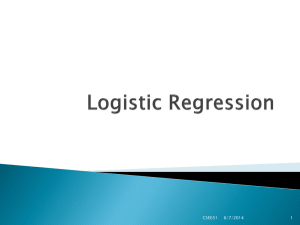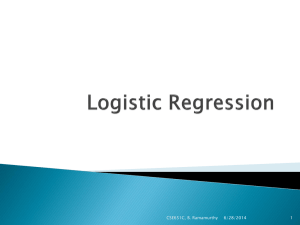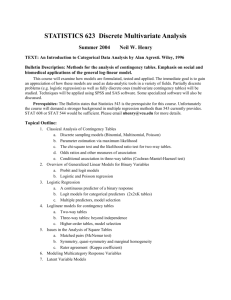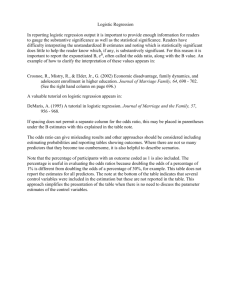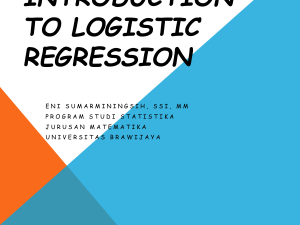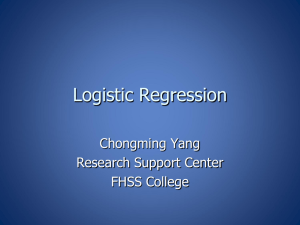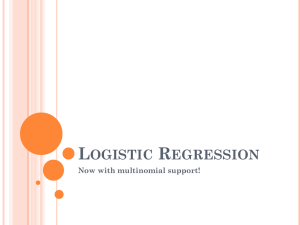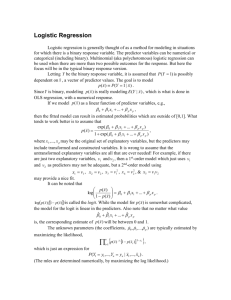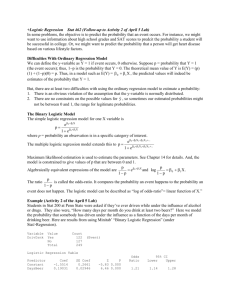Logistic Regression
advertisement
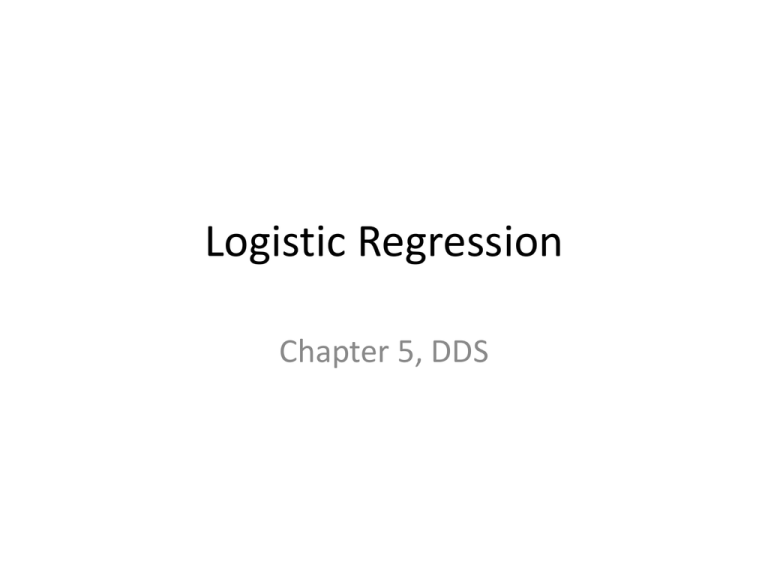
Logistic Regression
Chapter 5, DDS
Introduction
• What is it?
– It is an approach for calculating the odds of event happening vs other
possibilities…Odds ratio is an important concept
– Lets discuss this with examples
• Why are we studying it?
– To use it for classification
– It is a discriminative classification vs Naïve Bayes’ generative classification
scheme (what is this?)
– Linear (continuous).. Logistic (categorical): Logit function bridges this gap
– According to Andrew Ng and Michael Jordon logistics regression classification
has better error rates in certain situations than Naïve Bayes (eg. large data
sets) Big data? Lets discuss this…
• Goal of logistic regression based classification is to fit the regression curve
according to the training data collected (dependent vs independent
variables) . (During production this curve will be used to predict the class
of a dependent variable).
Logistic Regression
Predict
• mortality of injured patients
• if a patient has a given disease (we did this using Bayes) (binary
classification using a variety of data like age, gender, BMI, blood
tests etc.)
• if a person will vote Democratic or Republican
• the odds of a failure of a process, system or a product
• A customer’s propensity to purchase a product
• Odds of a person staying in the workforce
• odds of a homeowner defaulting on a loan
• Conditional Random Field (CRF) an extension of logistic regression
to sequential data, are used in NLP. It is labeling a sequence of
items so that an entity can be recognized (named entity
recognition).
Basics
• Basic function is: logit logistic regression
• Definition:
• logit(p) =
𝑝
log( )
𝑝−1
= log(p) – log(1-p)
• The logit function takes x values in the range [0,1]
and transforms them to y values along the entire
real line
• Inverse logit does the reverse, takes a x value
along the real line and transforms them in the
range [1,0]
Demo on R
• Ages of people taking Regents exam, single
feature Age
• Age Total Regents
• Do EDA
• Observe the outcome, if sigmoid
• Fit the logistic regression model use the
fit/plot to classify
• This is for small data of 25, how about Big data?
MR?
• Realtime response? Twitter model
R code: data file “exam.csv”
•
•
•
•
•
data1 <- read.csv("c://Users/bina/exam.csv")
summary(data1)
head(data1)
plot(Regents/Total ~Age, data=data1)
glm.out = glm(cbind(Regents, Total-Regents) ~Age,
family=binomial(logit), data=data1)
• plot(Regents/Total ~ Age, data = data1)
• lines(data1$Age, glm.out$fitted, col="red")
• title(main="Regents Data with fitted Logistic Regression
Line")
• summary(glm.out)
Lets derive this from first principles
1.
Let ci be the set of labels .. For binary classification (yes or no) it is i = 0,
1, clicked or not
2. Let xi be the features for user i , here it is the urls he/she visited
3. P(ci|xi) =
4. P(ci=1|xi) =
5. P(ci=0|xi) =
6. log Odds ratio = log (eqn4/eqn5)
7. logit(P(ci=1|xi) = α + βt Xi where xi are features of user i and βt is vector
of weights/likelihood of the features.
8. Now the task is to determine α and β
9. (many methods are available for this.. Out of the scope our discussion).
10. Use the logistic regression curve in step 7 to estimate probabilities and
determine the class according to rules applicable to the problem.
Multiple Features
click url1
1
1
0
1
1
url2
0
0
1
0
1
url3
0
1
0
0
0
url4
0
1
0
0
1
url5
1
0
1
0
0
0
1
0
0
1
“train” data
Fit the model using the command
Fit1 <- glm(click~ url1+url2 + url3+url4+url5, data=“train”, family=binomial(logit))
All the examples are by choice “very small” in size EDA
Evaluation
• Rank the ads according to click logistic
regression, and display them accordingly
• Measures of evaluation:
• {lift, accuracy, precision, recall, f-score)
• Error evaluation: in fact often the equation is
written in with an error factor:
logit(P(ci=1|xi) = α + βt Xi + err
Dow to select your classifier?
• Pages 115-117
• One alg.? or compendium of algorithms?
What is an exam question?
• Compute odds ratio given a problem.
• General question about logistic regression
concept. “intuition”
• Context of big data and MR
(already implemented in Mahout/apache)
